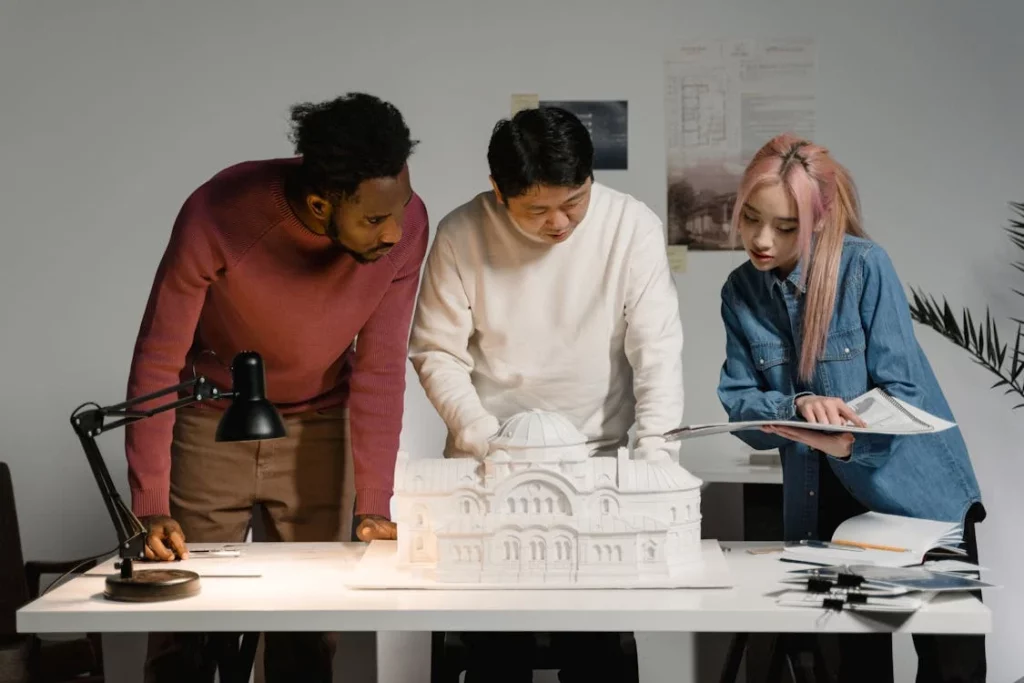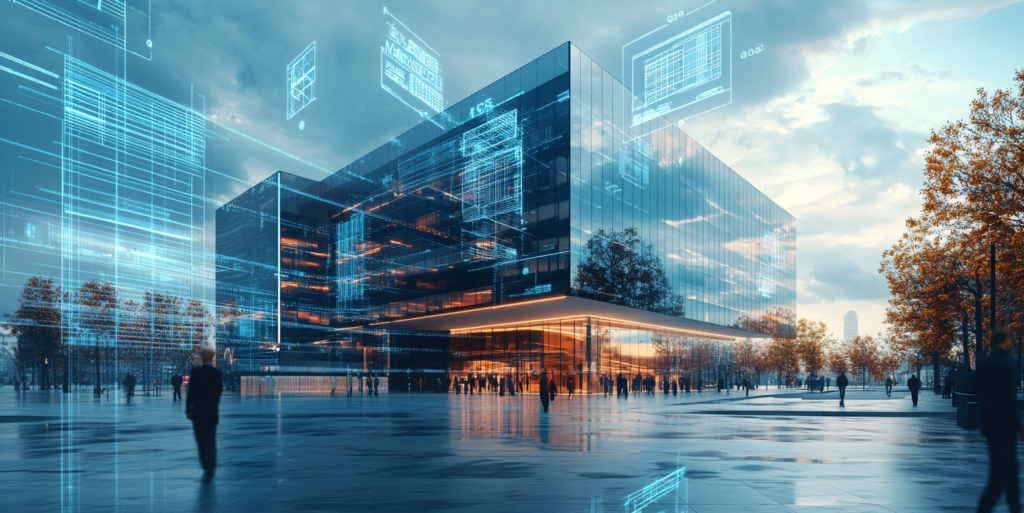The architectural profession is experiencing its most significant transformation since the introduction of computer-aided design. As AI tools like Midjourney, ChatGPT, and automated design software become increasingly sophisticated, one question dominates industry discussions: Will AI replace architects?
Industry experts at leading firms like BIG (Bjarke Ingels Group) suggest the answer is more nuanced than a simple yes or no. Based on real-world implementation at one of the world’s most innovative architecture firms, here’s what the future actually holds for architectural careers.
The Optimistic Reality: AI as Liberation, Not Elimination
“I’m actually more excited for new graduates than when I was in their position,” according to design technology experts at major firms. Rather than eliminating jobs, AI is poised to free architects from the most tedious aspects of their work.
What AI Will Handle:
- Endless nights photoshopping renderings
- Line-by-line CAD drawing
- Waiting hours for basic 3D renders
- Repetitive modeling tasks
- Time-consuming administrative work
What This Means for Architects:
More time for what architects do best: thinking, problem-solving, and creative design.
The Three Eras of Architectural Practice
Industry analysts have outlined a compelling framework for understanding this transition:
Architect 1.0 – The Manual Era: Hundreds of people drawing buildings by hand on massive floor plates
Architect 2.0 – The Computer-Aided Era: Current practices using computers as “computerized slaves” to execute tasks faster
Architect 3.0 – The AI Collaborative Era: Small, nimble teams collaborating with AI to tackle complex projects
Why Architects Won’t Be Replaced: The Irreplaceable Human Element
The Core Value Remains Unchanged
“The value of what we do as architects is still the thinking,” emphasize technology specialists at leading firms. This includes:
- Site research and analysis
- Understanding context and constraints
- Problem-solving unique design challenges
- Creating meaningful spatial experiences
- Navigating complex stakeholder relationships
AI’s Current Limitations
While AI excels at generating images and automating tasks, it lacks the critical thinking that defines architectural practice:
- No contextual understanding: AI images are “thoughtless” – visually appealing but lacking the research and reasoning behind design decisions
- Limited control: Current AI tools can’t precisely execute complex architectural requirements
- No problem-solving capability: AI can’t analyze sites, understand building codes, or solve unique design challenges
Red Flags vs. Green Flags: Reading the Market
| ⚠️ Red Flags (Avoid These Attitudes) | ✅ Green Flags (Embrace These Opportunities) |
|---|---|
| “AI is just a fad that will pass” | “AI is here to stay, I need to adapt” |
| “I’ll wait until the technology is perfect” | “I’ll learn as the technology evolves” |
| “AI will make my skills worthless” | “AI will make my thinking skills more valuable” |
| “I don’t need to change my process” | “I’ll experiment with new AI-enhanced workflows” |
| “Only tech people can use AI effectively” | “I can learn to collaborate with AI tools” |
The key message? Don’t ignore AI, but don’t fear it either. The thinking architect will always have a place in shaping our built environment.

How Architecture Practice Will Transform
Smaller, More Diverse Practices
The future may see:
- Teams of 5-15 people handling projects that previously required 50+ staff
- More diverse array of specialized practices
- Increased accessibility for smaller firms to compete on complex projects
New Collaboration Models
AI will function as a collaborator rather than a replacement, similar to how:
- Grasshopper scripts automate repetitive tasks
- Real-time rendering tools like Enscape give architects more control
- BIM software streamlines documentation
Essential Skills for the AI Era
What to Develop Now:
- AI Literacy: Understanding how to effectively use and prompt AI tools
- Design Thinking: Strengthening conceptual and problem-solving skills
- Collaboration: Learning to work alongside AI as a design partner
- Adaptability: Staying current with rapidly evolving technology
What Becomes Less Critical:
- Advanced CAD wizardry
- Manual rendering expertise
- Repetitive modeling skills
- Time-intensive visualization techniques
Strategic Career Positioning
| Career Stage | Immediate Actions | Long-term Positioning | Market Opportunity |
|---|---|---|---|
| Recent Graduate | • Build portfolio showcasing AI-enhanced projects • Demonstrate prompt engineering skills • Show traditional + AI hybrid workflows | Become the bridge between old and new methods | High demand for AI-native junior architects |
| Mid-Career | • Lead AI adoption in current firm • Develop training programs for colleagues • Specialize in AI implementation consulting | Position as transformation leader | Growing need for AI change management |
| Senior Architect | • Evaluate AI impact on firm strategy • Invest in AI technology partnerships • Mentor next generation on AI integration | Shape industry direction and standards | Opportunity to lead industry transformation |
| Firm Owner | • Develop AI implementation roadmap • Train entire team systematically • Explore custom AI model development | Create competitive advantage through early adoption | First-mover advantage in AI-enabled practice |
Industry Disruption: Yes. Job Elimination: No.
“It’s absolutely going to disrupt the industry. Do not make a mistake about it,” warn industry experts. However, disruption doesn’t equal destruction.
Expected Changes:
- Visualization firms face the most immediate pressure
- Entry-level positions will require AI familiarity
- Design processes will accelerate dramatically
- Project team sizes may shrink while output increases
New Opportunities:
- AI implementation specialists
- Design technology managers
- Prompt engineering experts
- Human-AI collaboration consultants
Real-World Implementation Insights from Leading Firms
Currently at major architecture firms, AI serves three primary functions:
- Idea Iteration: Using Midjourney as a “super Pinterest” for rapid concept exploration
- Automation: Leveraging ChatGPT for administrative tasks and research
- Visualization Enhancement: Integrating AI into rendering workflows for faster iterations
The firm continues experimenting with connecting design tools directly to AI platforms, though this remains largely experimental across the industry.
The “AI-Ready Architect” Mindset Framework
| Traditional Mindset | AI-Ready Mindset | Competitive Advantage |
|---|---|---|
| “I need to master every software” | “I need to understand what AI can do” | Speed: Faster tool adoption and integration |
| “Perfection takes time” | “Iteration leads to excellence” | Agility: Rapid testing and refinement of ideas |
| “I work alone on my designs” | “I collaborate with AI as a design partner” | Output: Higher volume of explored concepts |
| “Technology disrupts my workflow” | “I adapt my workflow to leverage technology” | Relevance: Staying current with industry evolution |
| “AI threatens my expertise” | “AI amplifies my expertise” | Value: Increased capacity for strategic thinking |
The Bottom Line for Your Career
For Current Architects:
- Don’t panic: Your core skills remain valuable
- Start experimenting: Familiarize yourself with AI tools now
- Focus on thinking: Strengthen your design reasoning and problem-solving abilities
- Embrace change: View AI as a powerful assistant, not a threat
For Architecture Students:
- Learn traditional skills: Understanding design fundamentals remains crucial
- Add AI literacy: Make prompt engineering and AI collaboration part of your toolkit
- Develop critical thinking: These skills will become even more valuable
- Stay adaptable: The tools will evolve, but learning how to learn is permanent
Preparing for an Uncertain but Exciting Future
“We’re in a very unique moment where our industry is going to change,” observe technology leaders at major firms. While the exact trajectory remains unpredictable, one thing is certain: architects who embrace AI as a collaborative tool while strengthening their uniquely human capabilities will thrive.
The future belongs to architects who can think critically, solve complex problems, and effectively collaborate with AI to create better buildings faster. Rather than replacing architects, AI promises to return the profession to its creative core – if we’re prepared to evolve with it.
Action Plan: Maximizing AI Opportunities in Architecture
| Timeline | Action Items | Tools to Explore | Skills to Develop |
|---|---|---|---|
| Start Today | • Create ChatGPT and Midjourney accounts • Practice basic prompting techniques • Follow AI architecture content creators | • ChatGPT for writing/research • Midjourney for concept visualization • Photoshop Generative Fill | • Prompt engineering • AI tool literacy • Critical evaluation of AI outputs |
| Next 3 Months | • Integrate AI into one project workflow • Join AI architecture communities • Test different AI visualization tools • Document what works/doesn’t work | • D5 Render AI features • Stable Diffusion with ControlNet • Runway for animations • Various AI plugins for CAD | • AI-human collaboration • Workflow optimization • Quality control for AI outputs |
| Next 6 Months | • Become the “AI person” in your office • Train colleagues on AI tools • Experiment with custom prompts for your firm’s style • Start building an AI-enhanced portfolio | • LookX AI • Hypar for generative design • Rhino + Grasshopper AI plugins • Unreal Engine basics | • Teaching and mentoring • Custom model training • Advanced prompting strategies |
| Next Year | • Lead AI implementation strategy • Explore creating firm-specific AI models • Network with AI technology companies • Consider specializing in AI-architecture consulting | • NVIDIA Omniverse • Custom model training platforms • API integrations • VR/AR with AI generation | • Strategic planning • Technology evaluation • Business development • Cross-industry collaboration |


